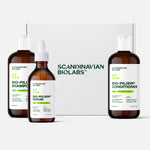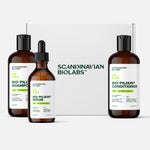Many people who have robust hair regimens refer to their hair as their crowning glory. The truth is, having good hair can give a massive boost in confidence.
Now, imagine your hair blowing freely in the wind, every strand shiny and silky. It sounds ideal, doesn't it?
Your hair is always a worthwhile investment but building a good hair care routine will require a bit more trial and error. Have you ever wondered why you put so much effort into caring for your hair, but the results are not what you expect?
Well, we might have an answer for you.
In this blog, we'll discuss the three types of hair regimens and their effects on your hair. Find out which of these hair regimens describes your routine the best so you can make adjustments to achieve the hair that you desire.
Summary
In her book, Davis-Sivasothy categorised hair regimens into 3 types: recessive maintenance, basic maintenance, and healthy hair regimens. The first one only worsens hair damage and the second one only helps maintain hair just above the point of faltering. Meanwhile, the last one supports hair improvement and nourishment.
To develop a healthy hair regimen, you can focus on protective styling, decide on trade-offs among the three hair care regimens, and invest adequate time. Protective styling is the approach in which your actions will protect and nourish your hair along with styling it.
Trade-offs among hair regimens allow you to have the desired hairstyles, but you need to take diverse measures to avoid more damage and maintain your hair health. Finally, fixing your damaged hair is a lengthy process which takes time and patience since there is no shortcut to sustainable strong hair.
What Is Your Hair Regimen?
In general, hair regimens can incorporate three broad categories: (1) recessive-maintenance regimens, (2) basic-maintenance regimens, and (3) healthy hair regimens.
The Recessive-Maintenance Regimen
A recessive-maintenance regimen means that your hair is deteriorating quicker than any benefit you gain from your hair maintenance efforts.
This is because many people still opt for a low-maintenance hair routine even after doing these things frequently on their hair:
- Hair straightening or curling
- Hair bleaching or dyeing
- Hair relaxing or perming
The most common signs you can see when you have a recessive-maintenance regimen is your hair length decreasing, thinning out, or balding. It won't take long before there is also reduced hair volume and quality.
While chemical alterations to your hair can immensely improve your looks, remember that these procedures are temporary but can result into permanent alterations with the state of your hair.
Constant and repeated hair abuse leads to scalp and hair damage, hindering the follicle vitality and altering hair structure. In short, you might end up with dry, damaged hair, or even worse, with no hair at all!
The hair products you pick also make a huge difference. In recessive-maintenance regimens, you are selecting the wrong choices in hair products.
For example, a low-maintenance hair care routine, with just ordinary shampoo and conditioner is a big no-no for chemically damaged hair.
Recessive-maintenance regimens never lead to any good results. In this regimen, hair damage often worsens with low-quality hair products even though your hair can look good for some moments due to instant fixes.
The Basic-Maintenance Regimen
This kind of regimen frequently happens for those who have a hectic life, resulting in minimum time and effort on hair care. It is also usually followed by those who do not want to or do not know how to take the initiative to go beyond this simple maintenance routine.
People with the basic-maintenance regimen typically use shampoo, conditioner, and limited styling products and treatments.
Based on the same practices and philosophy, the basic-maintenance regimen is somewhat similar to the recessive-maintenance one, albeit the former is less extreme than the latter.
One difference between them is that these routines maintain hair in such a state just before too much damage becomes visible. That is to say, the rate of hair damage more or less equals the rate of hair progress.
Hallmarks of this type of regimen include moderate use of relaxers, direct heat used for daily styling, high-manipulation styling with no protection of the hair shaft or ends, and infrequent hair cleansing and conditioning.
Still, this type of hair care routine is likely to turn into the recessive type once there is a prolonged lack of knowledge and intervention in hair care processes. The effects of this regimen are even more drastic on Black hair, whose texture needs consistent upkeep and styling.
The Healthy Hair Regimen
Healthy hair regimens ensure that hair emergence and retention complement one another over an extended period by limiting the hair exposure to external damage.
As the name suggests, these regimens can adequately improve hair integrity and assist hair wellness while lessening hair damage over time. Also, they need to be a consistent routine in order to yield lasting results that can last for years.
If you want your locks to be lively with steady improvement, this is the measure you should aim for. In crafting your own healthy hair regimen, you need to pay careful attention and experiment with some products and routine to achieve that perfect balance.
This level of care is what will give you sustainable robust hair regardless of the status quo.
Some basic principles of a healthy hair regimen are:
- Low-manipulation hair styling
- Protection of hair shaft and ends from heat and physical damage
- Maintaining natural hair with high-quality hair products and no chemical processes
- Using chemical aids only after every ten to twelve weeks at least
How To Create A Healthy Hair Regimen
Protective Styling
Because hairstyling accounts for one of the most common causes of damaged hair, taking protective measures is necessary to make sure you keep your hair strong and free of damage.
To do this, you'll need to take deliberate steps to protect your hair, including finding the right products and using an appropriate amount of them, as well as reducing the use of chemical treatments or aggressive hairstyles when possible.
You can also choose products that balance out protein and moisture levels so that they're not too dry or too oily.
Trade-Offs Among Hair Regimens
You might not be aware of this but there is a way to keep your hair looking its best while keeping it styled in ways you love.
To do this, you have to consider what type of hair care practices best suit you and come up with a plan on how to always aim for a healthy hair regimen. It includes trade-offs where you create a unique routine based on your own needs.
For example, if you don't have enough time to take extra measures in your hair regimen, maybe all you need is an at-home routine that doesn't require much heat styling work.
Alternatively, when your hair starts to feel dry after a permanent dye, you will need extra effort to condition and nurture your dyed hair and scalp.
Time Investment
It is critical to acknowledge that a regimen requires commitment, so the notion of having overnight results is just delusional. Furthermore, in order to gain sustainable results, quick fixes don't exist, especially when your hair has suffered intensive damage.
Ultimate results from hair care efforts come from the time one invests in caring for their hair.
It should be well known that the time factor varies among individuals; but basically, the more your hair gets damaged, the more time you need to fix it.
While some major signs of hair transformation might appear very soon, others could take weeks or months.
For instance, improvements in thickness and pliability can be observed weeks, even months before noticeable advancement in length.
Some Suggestions For Your Healthy Hair Regimen
The wrong kinds of shampoo, heated styling tools, and sun exposure can affect the hair colour and properties, causing it to fade, turn brassy, and look lifeless.
Choose a shampoo designated for your hair type and condition, such as sulfate-free for colour-treated hair.
A nourishing shampoo and conditioner will help lock in moisture and prevent frizz, which helps tremendously for dry, damaged hair and curly hair. Once a week, use a hydrating mask on your hair to give it the extra boost needed.
Let your hair air dry or blow-dry using a diffuser attachment with low heat. A thermal protectant cream is desirable before using any heated tools to avoid burning strands. Likewise, a UV-protectant spray is also essential to shield against sun damage, particularly if you live in sunny areas.
In the case of fine and limp hair, thickening shampoo and conditioner helps to bulk it up.
You may want to stay away from heavy, oil-based products and conditioning masks since they can weigh your style down.
If your fine hair gets dry, try a leave-in volumising treatment with moisture-induced ingredients to hydrate and plump up strands simultaneously.
Read more:
Disclaimer:
The information we provide is not intended to mitigate, prevent, treat, cure or diagnose any disease or condition. If you have any concerns about your health, please consult your doctor.
References
Davis-Sivasothy, A. (2011). The science of black hair: a comprehensive guide to textured hair. SAJA Publishing Company.
Kim, C. (2008, Feb 18). Pick your perfect hair regimen. Us Weekly, 92-93.







